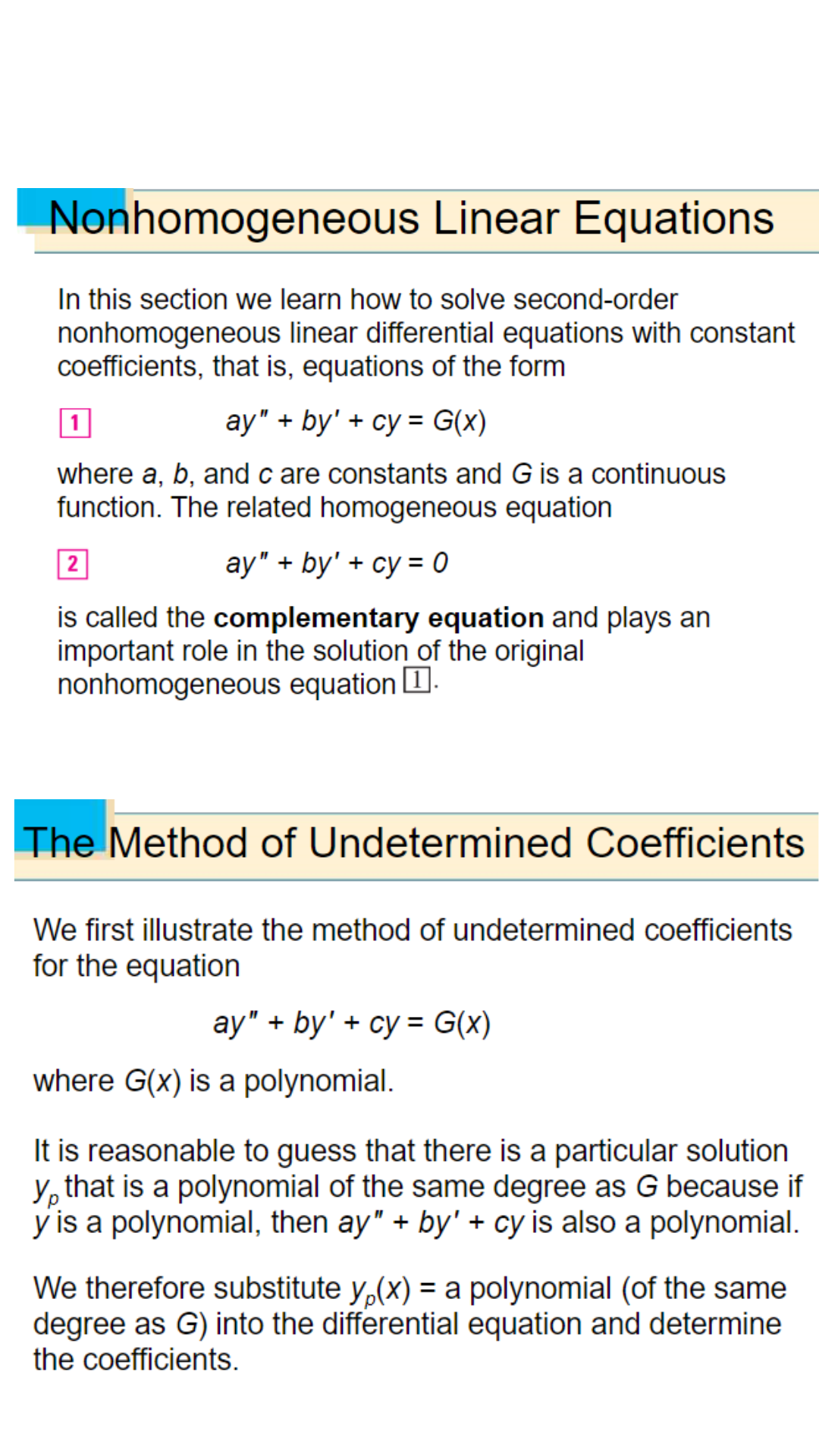Nonhomogeneous Linear Equations In this section we learn how to solve second-order nonhomogeneous linear differential equations with constant coefficients, that is, equations of the form 1 ay" +by' + cy= G(x) where a, b, and c are constants and G is a continuous function. The related homogeneous equation 2 ay" + by' + cy=0 is called the complementary equation and plays an important role in the solution of the original nonhomogeneous equation [. The Method of Undetermined Coefficients We first illustrate the method of undetermined coefficients for the equation ay" + by' + cy= G(x)
Nonhomogeneous Linear Equations In this section we learn how to solve second-order nonhomogeneous linear differential equations with constant coefficients, that is, equations of the form 1 ay" +by' + cy= G(x) where a, b, and c are constants and G is a continuous function. The related homogeneous equation 2 ay" + by' + cy=0 is called the complementary equation and plays an important role in the solution of the original nonhomogeneous equation [. The Method of Undetermined Coefficients We first illustrate the method of undetermined coefficients for the equation ay" + by' + cy= G(x)
Calculus: Early Transcendentals
8th Edition
ISBN:9781285741550
Author:James Stewart
Publisher:James Stewart
Chapter1: Functions And Models
Section: Chapter Questions
Problem 1RCC: (a) What is a function? What are its domain and range? (b) What is the graph of a function? (c) How...
Related questions
Question
Differential equations
Determine the solution for the following higher-order nonhomogeneous differential equation. Also, determine the constant coefficients if the initial condition is given.
PS: use the given methods below, thank you.

Transcribed Image Text:Nonhomogeneous Linear Equations
In this section we learn how to solve second-order
nonhomogeneous linear differential equations with constant
coefficients, that is, equations of the form
1
ay" +by' + cy= G(x)
where a, b, and c are constants and G is a continuous
function. The related homogeneous equation
2
ay" + by' + cy=0
is called the complementary equation and plays an
important role in the solution of the original
nonhomogeneous equation [.
The Method of Undetermined Coefficients
We first illustrate the method of undetermined coefficients
for the equation
ay" + by' + cy= G(x)
where G(x) is a polynomial.
It is reasonable to guess that there is a particular solution
y, that is a polynomial of the same degree as G because if
y is a polynomial, then ay" + by' + cy is also a polynomial.
We therefore substitute y(x) = a polynomial (of the same
degr as G) into the differential equation and determine
the coefficients.

Transcribed Image Text:y' +5y' +6y=2x
бу=2x
Expert Solution
This question has been solved!
Explore an expertly crafted, step-by-step solution for a thorough understanding of key concepts.
Step by step
Solved in 2 steps with 2 images

Recommended textbooks for you

Calculus: Early Transcendentals
Calculus
ISBN:
9781285741550
Author:
James Stewart
Publisher:
Cengage Learning

Thomas' Calculus (14th Edition)
Calculus
ISBN:
9780134438986
Author:
Joel R. Hass, Christopher E. Heil, Maurice D. Weir
Publisher:
PEARSON

Calculus: Early Transcendentals (3rd Edition)
Calculus
ISBN:
9780134763644
Author:
William L. Briggs, Lyle Cochran, Bernard Gillett, Eric Schulz
Publisher:
PEARSON

Calculus: Early Transcendentals
Calculus
ISBN:
9781285741550
Author:
James Stewart
Publisher:
Cengage Learning

Thomas' Calculus (14th Edition)
Calculus
ISBN:
9780134438986
Author:
Joel R. Hass, Christopher E. Heil, Maurice D. Weir
Publisher:
PEARSON

Calculus: Early Transcendentals (3rd Edition)
Calculus
ISBN:
9780134763644
Author:
William L. Briggs, Lyle Cochran, Bernard Gillett, Eric Schulz
Publisher:
PEARSON

Calculus: Early Transcendentals
Calculus
ISBN:
9781319050740
Author:
Jon Rogawski, Colin Adams, Robert Franzosa
Publisher:
W. H. Freeman


Calculus: Early Transcendental Functions
Calculus
ISBN:
9781337552516
Author:
Ron Larson, Bruce H. Edwards
Publisher:
Cengage Learning